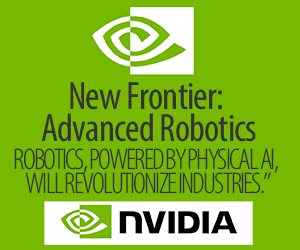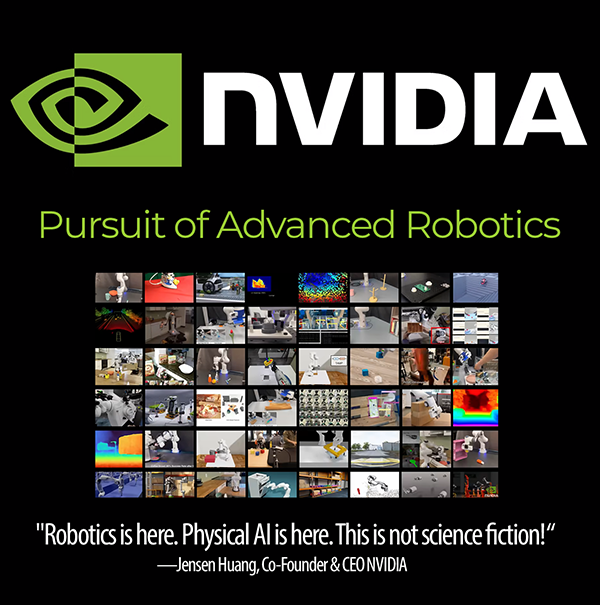“Robotics is here. Physical AI is here. This is not science fiction. It’s just really, really exciting. All the factories will be robotic. The factories will orchestrate robots, and those robots will be building products that are robotic.”
–Jensen Huang, CEO NVIDIA
NVIDIA’s Pursuit of Advanced Robotics:“Smart” industrial robots, cobots, AMRs, and the toughest of newbies: humanoid robots
NVIDIA, the powerhouse tech giant of combining accelerated computing, GPUs (graphics processing units), and GenAI (generativeAI), has set its sights on a new frontier: Advanced robotics, with a vision of being integral to birthing a new age in “smart” industrial robots, cobots, AMRs, and the newest of the new, humanoid robots.
All of that was set out by founder and CEO Jensen Huang at NVIDIA’s GTC 2024 conference, back in March. Holding aloft the Blackwell GPU with 208 billion transistors, he beamed to a full house of 16,000 cheering supporters: “Now we can even talk to warehouses.”

NVIDIA hasn’t stopped to catch its breath since. Huang is barnstorming the message to anyone and everyone; his recent frequent-traveler miles must border on the humongous!
It’s not that we’ll see the company’s own NVIDIA-built humanoids anytime soon, but rather, an NVIDIA GPU (graphics processing unit) is a key component in quickly processing large amounts of data, which is ideal for running complex algorithms, and necessary for intelligent robotics, smart factories, and intelligent logistics to thrive. It’s going to be more like “NVIDIA inside,” similar to how the well-worn and memorable “Intel Inside” was for computing. This time around, however, it’s NVIDIA really getting inside of anything that needs GenAI and accelerated GPU computing, which is turning out to be just about everything.
Take humanoids, for example
Advanced robotics, like smart industrial robots and humanoids, is a great way for NVIDIA to diversify away from deriving some 84% of its revenue from the data center crowd, the likes of Alphabet, Microsoft, Meta, and Amazon, each of which buys $3-plus billion of NVIDIA’s GPU chips annually. Barely 25% of NVIDIA’s business comes from robotics, which the company needs to bulk up if data-center sales turn volatile.
Similarly, NVIDIA’s recent partnering with Accenture is a brainstorm of how to get NVIDIA’s tech nicely nestled into thousands of corporations worldwide and create another eye-popping revenue stream to balance off data centers. Especially since, as the WSJ reported, “many companies have been slow to adopt new AI tools and services that use that infrastructure in their everyday operations. That reflects concerns about costs, effectiveness, uncertainty over regulations and data security, among other issues.” Handholding from an NVIDIA/Accenture team will do wonders to get the GenAI ball rolling with corporations as well as serve as an ideal confidence builder and morale booster for corporate doubters.

NVIDIA’s “bromance” with humanoid robots is an ambitious move that comes with considerable technical challenges, signaling that the road ahead for NVIDIA’s CEO may be more complex than previously anticipated. Nevertheless, the potential rewards, both in terms of societal impact and financial gains, make the pursuit of humanoid robots a powerful endeavor that could shape the future.
“Robotics is here. Physical AI is here. This is not science fiction,” Huang confidently declared. Despite NVIDIA’s aspirations, the company must navigate some formidable obstacles. The semiconductor industry, which forms the backbone of NVIDIA’s revenue through data centers, is known for its volatile boom-and-bust cycles. Diversifying into a stable new market, like robotics, is a logical step. Yet, robotics currently constitutes only a small fraction of NVIDIA’s revenue, and the task of transforming it into a major growth engine will not be straightforward.
While recent technological advancements, especially in artificial intelligence (AI) and cloud computing, are key enablers that can unlock the potential of robotics, the complexity of the field cannot be understated. However, for those organizations that can unlock the difficulties, there are great rewards to be reaped. According to a Yahoo Finance report, AI and cloud computing enable robots to collaborate seamlessly and access large volumes of data, which will help the robotics industry grow at a projected compound annual growth rate of 14% between 2023 and 2030. This growth is expected to push the industry’s value from $76 billion in 2023 to $217 billion in 2030. That’s more than triple in a scant seven years!
The promise of humanoids
The robotics industry is divided into two primary segments: industrial robots and service robots. Industrial robots, which have been part of manufacturing environments for decades, are valued at $23 billion in 2023 and are expected to grow to $45 billion by 2030.
The service robot segment, however, presents the greatest growth opportunity. This segment, valued at $52 billion in 2023, is forecast to more than triple, reaching $172 billion by 2030. Service robots are still in their early stages of development compared to industrial robots, and they hold tremendous potential for growth, especially in consumer-facing industries like healthcare, hospitality, and domestic settings.
"We shape our tools and thereafter our tools shape us." -Marshall McLuhan
For NVIDIA, humanoid robots represent a particularly promising opportunity. As Huang pointed out, humanoids could be easier to build since the world is designed for humans, which makes adaptation theoretically simpler. He noted, “The easiest robots to adapt in the world are humanoid robots because we built the world for us. There’s more data to train these robots because we have the same physique.” Yet, gathering and processing the immense amounts of data required to train these robots remains costly and time-consuming. Tesla, for instance, is compensating people at $48 an hour to perform tasks in special suits to gather movement data for its humanoid robot, Optimus.
Despite these challenges, the potential for financial gain and broad adoption is massive. Analysts from research firm William Blair have highlighted NVIDIA’s capabilities in robotics and digital twins, noting that they could become enormous businesses on their own. The company’s partnerships with leading organizations, such as BMW, Boston Dynamics, BYD Electronics, and Siemens, demonstrate the significant investments being made to develop AI-driven robots, from robotic arms in factories to fully functional humanoids.
Yet, the complexities of developing humanoid robots are immense. Robotics is a confluence of mechanical engineering, software development, and physics—all at once. This complexity is what sets robotics apart from language-based AI, which has benefited from foundational models and tools that allow anyone, even without an advanced degree, to build AI applications.
Creating the truly transformative
The robotics industry has yet to reach a point where development is similarly democratized. Huang’s goal for NVIDIA’s robotics stack is to lower the barrier to entry, but working with AI in physical spaces presents far more significant difficulties than dealing with purely virtual data.
See related: What Makes Humanoids Tick?
The competitive landscape for robotics is also heating up, with several players, including startups like Scaled Foundations and Skild AI, working to develop open and accessible robotics platforms. Ashish Kapoor, former head of Microsoft’s robotics research (now founder and CEO of Scaled Foundations), is among those emphasizing the importance of collaboration across the robotics community to solve these challenges effectively. The market for robotics is indeed enticing, but the road to commercializing versatile humanoids is fraught with obstacles.
The development of humanoid robots requires more than just intelligence—it necessitates the ability to interact with and
 adapt to complex, unstructured environments. While robotic arms have been used for repetitive, predefined tasks in factories since 1961, making them truly “intelligent” with AI is a different challenge entirely. Unlike their unintelligent predecessors, AI-enabled robotic arms need the capability to handle diverse tasks autonomously—recognizing different objects, adapting their actions in real-time, and ensuring safety in dynamic environments. Humanoid robots add an even greater level of complexity, needing to navigate human environments while replicating the full range of human physical abilities.
adapt to complex, unstructured environments. While robotic arms have been used for repetitive, predefined tasks in factories since 1961, making them truly “intelligent” with AI is a different challenge entirely. Unlike their unintelligent predecessors, AI-enabled robotic arms need the capability to handle diverse tasks autonomously—recognizing different objects, adapting their actions in real-time, and ensuring safety in dynamic environments. Humanoid robots add an even greater level of complexity, needing to navigate human environments while replicating the full range of human physical abilities.
Given the immense costs and technological hurdles associated with creating humanoids, some experts question whether pursuing them is the right goal. A former NVIDIA robotics expert expressed skepticism, pointing out that the versatility and cost-effectiveness of humanoids might lag behind specialized robots designed to do one task exceptionally well. Nonetheless, NVIDIA remains fully committed, as Huang continues to push the boundaries of what’s possible in AI-driven robotics.
The pursuit of humanoid robots is not merely about overcoming engineering challenges—it is about creating something profoundly transformative. Complete automation of industrial and service robots, enabled by AI, has the potential to revolutionize manufacturing, healthcare, logistics, and countless other sectors. A future where robots take on roles that involve physical labor, dangerous tasks, or highly repetitive work could not only reshape entire industries but also yield immense financial rewards for companies like NVIDIA that lead the way.
NVIDIA’s venture into advanced robotics, particularly humanoid robots, is burdened with technical and financial challenges. However, the potential payoffs are vast. The successful development and deployment of humanoid robots could address critical labor shortages, enhance productivity across multiple industries, and secure NVIDIA’s place as a leader in AI and advanced robotics.
While the journey will undoubtedly be difficult, the value of these robots—both in societal impact and financial return—makes it a more than worthwhile pursuit for very well-heeled companies like NVIDIA, especially those with a visionary leader like Huang who is hellbent on pioneering the advanced robotics in all of its forms

